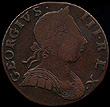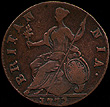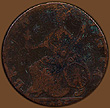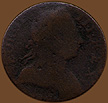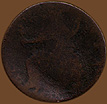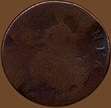Counterfeit British Coppers
George III
obverse |
|
reverse |
| |||
Halfpenny 1772 George III counterfeit
Obverse: GEORGIVS . III . R E X .
Reverse: BRITAN N I A . 1772
Weight: 105.6 g (6.84 grams) Diameter: 27.6 mm
Comments: The obverse bears a portrait of George III while the reverse bears a Britannia design. This lightweight halfpenny is a full 25% under the minimum acceptable weight of 140 grains. The obverse has a distinctive pointed nose bust, with the nose pointing to the vertical stroke of the R. Also the S in GEORGIVS is somewhat distant and in REX the E and X in REX are distant with the end on the X and the final stop very close to the bust. Not illustrated in Anton and Kesse.
The reverse is similar to Anton and Kesse, figure 83. Britannia's hand points between the I and T and the top leaf points to the corner of the N. The bottom of the pole points to the right of the 1 in the date. This example differs from Anton 83 in that the second 7 in the date appears higher than in their plate.
Provenance: Donated to Notre Dame in 1887 as part of a 2,300 item coin collection (see: The Notre Dame Scholastic, vol. 21 (September 1887) 45.
obverse |
|
reverse |
| |||
Halfpenny 1775 George III counterfeit
Obverse: GEORGIVS III . REX .
Reverse: BR[IT]AN .NIA . 1775
Weight: 105.3 g (6.82 grams) Diameter: 26.6 mm
Comments: The obverse bears a portrait of George III while the reverse bears a Britannia design. This lightweight halfpenny is another example that is a full 25% under the minimum acceptable weight of 140 grains. The obverse and reverse appear to be close to Anton and Kesse, figure 16 except on the reverse of our example the A appears closer to the shield and the final stop is higher up near the rim (aligned with the top of the A rather than the center of that letter). This is a pitted and worn example with verdigris in which the date has been scratched onto the obverse of the coin behind the head and again under the bust.
Provenance: Donated to Notre Dame in 1887 as part of a 2,300 item coin collection (see: The Notre Dame Scholastic, vol. 21 (September 1887) 45.
obverse |
|
reverse |
| |||
Halfpenny George III undated counterfeit
Obverse: GEORGI[VS] . III . REX .
Reverse: [BR]I[TAN] [N]IA
Weight: 67.5 g (4.38 grams) Diameter: 26.7 mm
Comments: The obverse bears a portrait of George III while the reverse bears a Britannia design. Although it has the normal diameter of a halfpenny this extremely lightweight specimen is an amazing 52% under the minimum acceptable weight of 140 grains. Indeed it is even under the minimum acceptable weight for a farthing (69.9g). The diameter is small but larger than a farthing. If this example was any smaller it would be mistaken as a farthing! It is rather a porous and apparently well worn example that has been bent at the edge from about 9:00 - 12:00 o'clock.
Provenance: Donated to Notre Dame in 1887 as part of a 2,300 item coin collection (see: The Notre Dame Scholastic, vol. 21 (September 1887) 45.
obverse |
|
reverse |
| |||
Halfpenny George III undated counterfeit
Obverse: G[EO]RG[IVS] III . R[EX] .
Reverse: [BRI]TA[N] NIA .
Weight: 100.1 g (6.48 grams) Diameter: 27.7 mm
Comments: The obverse bears a portrait of George III while the reverse bears a Britannia design. This lightweight halfpenny is 30% under the minimum acceptable weight of 140 grains. The coin appears to be well worn but may be due to a shallow cut die and intentional die breaks. Note the obvious die break under the bust. I suspect the three worn areas in the obverse legend are not just due to actual wear but reflect intentional die breaks added to the die to obstruct the legend and make the coins appear worn. With examples such as this in circulation durn the late eighteenth century it is easy to understand the development of Blacksmiths.
Provenance: Donated to Notre Dame in 1887 as part of a 2,300 item coin collection (see: The Notre Dame Scholastic, vol. 21 (September 1887) 45.
| Counterfeit British Coppers: p. 1 | Section Contents | Counterfeit Irish Coppers |
|
For viewing tips and information on optimal computer settings click
here.
For questions or comments contact Special Collections by: |
